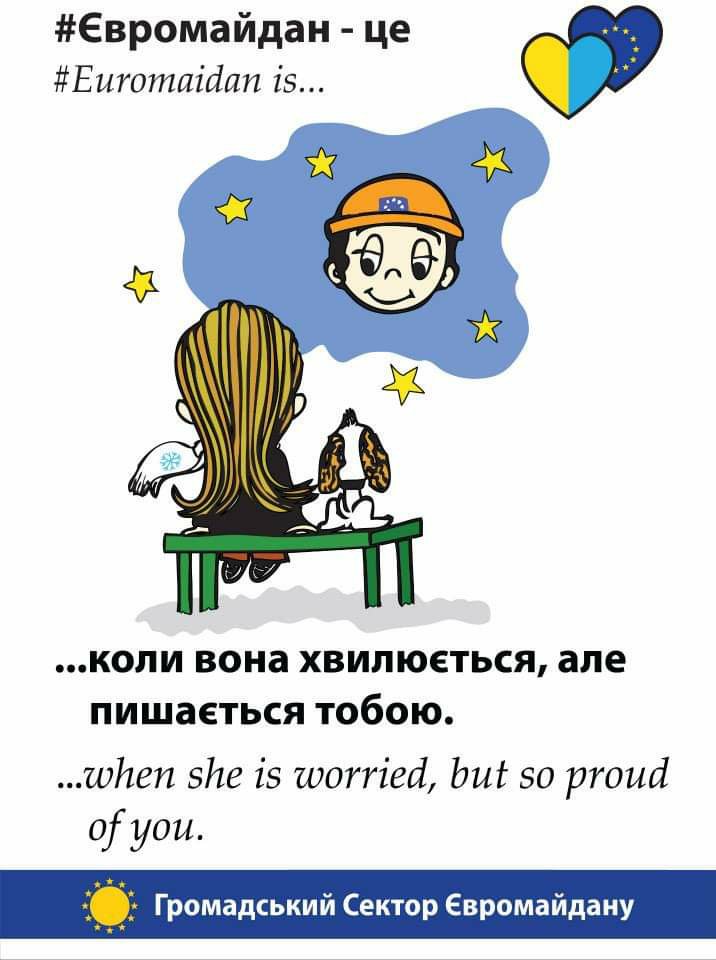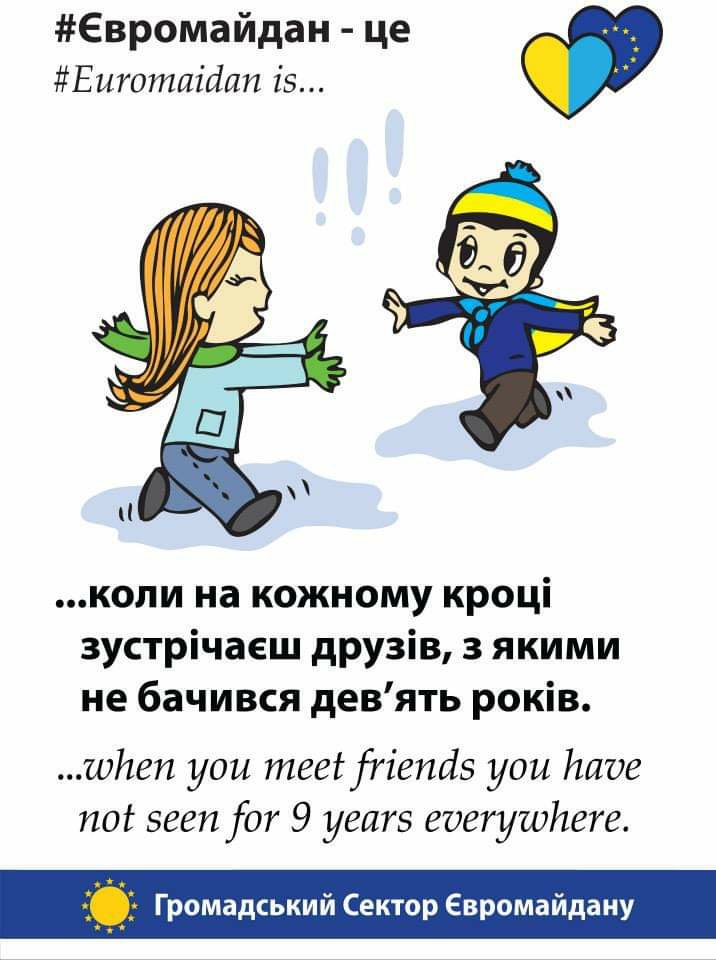Nevertheless, it is widely believed that the Revolution won. Even now, after seven years, Euromaidan is seen as a touchstone, a starting point for all developments and reforms, and a benchmark for measuring whether the revenge of the ancien regime is taking place.
While the investigation of the tragic events is still not completed and the guilty are not punished, the comprehension of the Revolution’s meaning is an ongoing process in which Ukraine is living. The National Memorial to the Heavenly Hundred Heroes and Revolution of Dignity Museum is the institution called to structure this experience. Euromaidan Press talked to Olha Salo, Deputy Head of the Museum of the Revolution of Dignity for Development, Scientific and Educational Work about Ukraine’s efforts to keep the memory about Euromaidan.
Olha is from Lviv, but she took part in the Euromaidan Revolution in Kyiv from the first to the last day. During it, she was a part of the initiative called Civic Sector of Euromaidan. Its main function was to provide the protest with everything needed -- food, warm closing, transport etc. The initiative was known for its pictures “Euromaidan is…”, copying the style of the famous “Love is….” bubble gums.

Before holding a position in the Museum, Olha worked as a freelance designer.
“For me, it is a great chance to implement my ideals. Now I have an opportunity to do things that I was doing anyway in my free time, but now on an institutional level. And this is a very powerful institutional opportunity. Of course, civic activism is the basis of civil society. However, if the state will not take responsibility for such key directions, these civic activities will stay underground. Now we have the opportunity to cooperate with society and to do it fully on the state level. It’s a big honor.”
What is the Museum? Definitely not only a building, Olha stresses. However, a building is also an important part. So far the Museum is only on the way to having its own permanent space.
What the Heaven's Hundred Memorial and Revolution of Dignity Museum is about
“As of today, the National Memorial Complex of Heroes of the Heaven's Hundred and the Revolution of Dignity is very active. Essentially it includes two key tasks. The first is a Memorial to the Heroes of the Heavenly Hundred and the second is the Museum of the Revolution of Dignity.
Land plots have already been allocated for both the memorial and the museum. Preparatory work has been done - a competition has been held, we approximately understand what the museum and the memorial should look like. The construction should have already started, but each of these facilities has its own problems that do not allow to complete it immediately.
But at the same time, and perhaps most importantly, the museum is not a territory, not a room.
It is an activity. And we are looking for different ways to carry out our direct responsibilities -
to preserve the memory about the Revolution of Dignity, affirm the honor of the Heaven's Hundred Heroes, and in the general promote the topic of the Ukrainians’ fight for their rights and freedom, as well the values of democracy, freedom, and dignity."
- Read also: Euromaidan “key event of state-building,” states Ukrainian Parliament to repel Russian propagandists
As the Museum does not have its own space yet, activities are held at various other locations.
What the Museum does
“We are now standing in the information and exhibition center of the Maidan Museum. A small room, only a little over 100 square meters on two floors in the House of Trade Unions. … it's not so much an exhibition space as a space for meetings, events, and an information center. Here you can come and book a tour. We have a number of tours depending on the needs and age category, the time that the listener is willing to devote to this topic. There are various events -- artistic, educational, scientific, conferences, forums, film presentations. It has become a hub uniting people who are thematically close to the theme of the Revolution of Dignity.
And also here there is a small exhibition space with original exhibits. Of course, this is only a small part of those artefacts that are stored in the funds of the Museum of Revolution of Dignity. But in this way, we want to remind of the need to build a museum. Because it is obvious that the museum should reveal different sides and different meanings of Euromaidan and what happened in Ukraine and with Ukrainians in 2013-2014.
We also have a location which we call Cube. The full name is 'Educational and exhibition space Cubed M - Maidan Memorial Museum.' This is a large structure on the site of the future Museum of the Revolution of Dignity, which also has a space for educational projects, meetings, events, but also it has an open-air exhibition where we talk about the Revolution of Dignity and the context of the Revolution of Dignity in Ukrainian history. And in general about the world context of Euromaidan.
Also around the Independence Monument, there are large metal structures, where we systematically hold exhibitions.
Now, we have an exposition devoted to the continuity of the liberation movement, which compares of various processes of the 20th-century liberation struggle with the Revolution of Dignity and the Orange Revolution. We want to show that these phenomena did not arise by themselves. That in essence, they are a continuation of the previous stages of the struggle. Each time requires a different format of a struggle for independence. And the struggle continues.
Also, the Museum is a fund, holds scientific activities, and educational work. We pay a lot of attention to forming good educational materials for schoolchildren, for young people. We understand that this is a separate target audience, which is probably one of the most valuable ones for us.
In terms of scientific activity, last year the National Museum of the Revolution of Dignity announced already a second international scientific forum on the Revolution of Dignity. It brought together scientists from around the world to analyze what these color revolutions mean in the context of the history of Ukraine, in the global context and in various thematic contexts.”
The Museum constantly investigates how society’s attitude to Maidan changes.
How the public perception of Maidan changes
“Of course, there was euphoria after the Maidan. And even then it was necessary to objectively understand that with time it will decline. Moreover, the euphoria of victory ended very quickly, literally in a few days by Russia's military aggression and the occupation of part of Ukrainian lands, and further complex processes. But it’s quite natural. In general, the world experience of revolutions has given rise to many people who declare that they were disappointed in the Revolution of Dignity and that perhaps it was not so necessary. However, despite this, we note that the majority of Ukrainians believe that the Revolution of Dignity was an important stage and a necessary stage in the history of Ukraine. It is very important for us to record society’s perception, how the dynamics of perception of the Revolution of Dignity change to form our activities and educational programs correctly.
At the end of last year, we ordered two comprehensive sociological studies. The first was among the adult population, and the second among high school students.
In general, I can say that the positive perception declined slightly. But there is one interesting point. We had a question among the adult population “How did you feel about the Revolution of Dignity when the Maidan took place, and how do you feel now?”. And the percentage of people who felt negatively about the revolution, but then realized it was necessary, increased compared to 2018, when we also conducted this analysis.
This means that the number of people who believe in these values and realize that this struggle and all that happened in Ukraine ever since was necessary for our further development has also increased.
We will try to raise and affirm the status of this event. Not to somehow assert it, but so it will remain a guide for the future. That's why we work.”
.
At the presentation, Anton Drobovych, the Head of the Ukrainian Institute on the National Memory explained that the poll is a guide for educators and authorities on how to act. The survey covered all regions of Ukraine.
“The results of the study worried me. 8% of the surveyed students know a lot about the Revolution of Dignity, and 84% are familiar with the subject. This 8% of solid knowledge is an alarming figure that shows that we need to work better. Most of the work is left for school, family, media,” Drobivych said.
Is Ukraine at the stage of comprehending Euromaidan, or is it still in the fight?
“I think that the process of comprehension started immediately the day after the Revolution. Because this process involves accepting certain changes towards oneself and society in general.
Society is changing. In fact, what Ukraine was before Euromaidan in 2013-2014 is different from Ukraine now. Despite all the failures, we can talk about the success of a number of reforms. The system of power-state relations has changed. The importance of citizens in the country has increased for the government. The authorities have to react to them. And authorities are obviously looking for an understanding with them.
Regarding revanchist sentiments, Ukraine, unfortunately, has a very dangerous neighbor who invests a lot in these sentiments. They are not by themselves. They are not a disappointment per se. They are a disappointment growing out of the barrage of negativity that is being dumped on the Revolution of Dignity and denigrating those values. The problem is not that specific historical events are questioned. The problem is that values are questioned.
The research among schoolchildren showed that when asked what they consider the greatest value, they answered the independence of Ukraine. And it gives us hope and optimism in our activities. The recent closing of the channels [on 2 February 2021, Ukraine sanctioned three pro-Russian channels] also gives hope, because it is possible that if there is no such insane information attack, information aggression against our population here in Ukraine, perhaps the perception will change. It is the question of the objectivity of this perception. Are we really judging reality by our experiences or imposed patterns? We think that countering the information attack is also one of the Museum's tasks.
Read also:
- Ukraine sanctions TV channels of Putin’s top-tier ally in Ukraine. Here is what they broadcasted
- No, Putin’s compadre shouldn’t be allowed to run propagandist TV in Ukraine
For the Day of Dignity and Freedom [21 November, when the Revolution started], we have distributed scientific and methodological information “Why the revolution of dignity can not be considered a coup d'etat”. Before that, there have never been such attacks on our social media pages. We were simply overwhelmed by bot attacks. And the site even stopped working for a while. We believe that this is one of our tasks - to repeat that citizens have the right to chose, in particular, to choose the right to national self-determination, state self-determination. Once we chose independence. And the Revolution of Dignity was, in particular, a struggle to defend it.”























